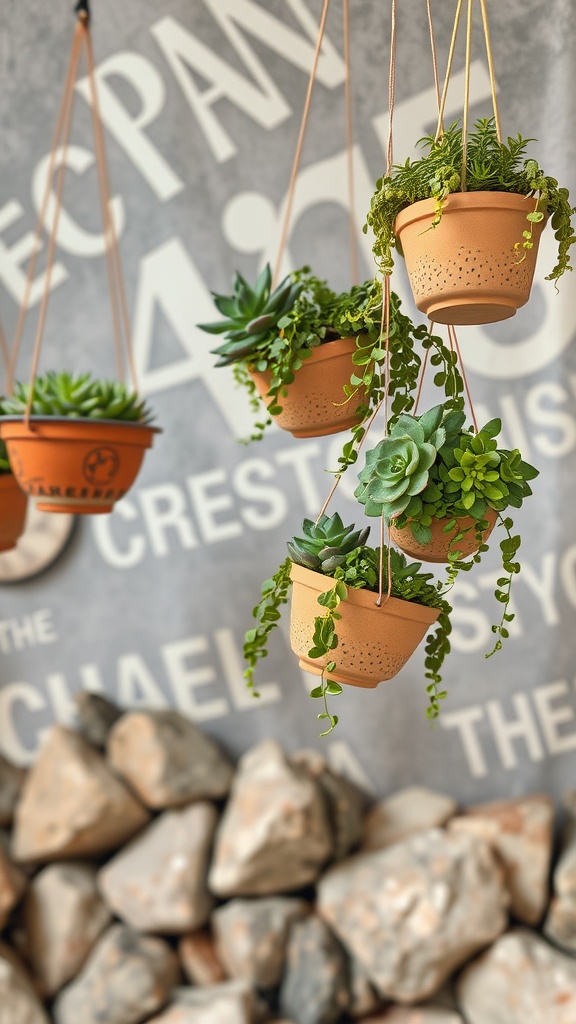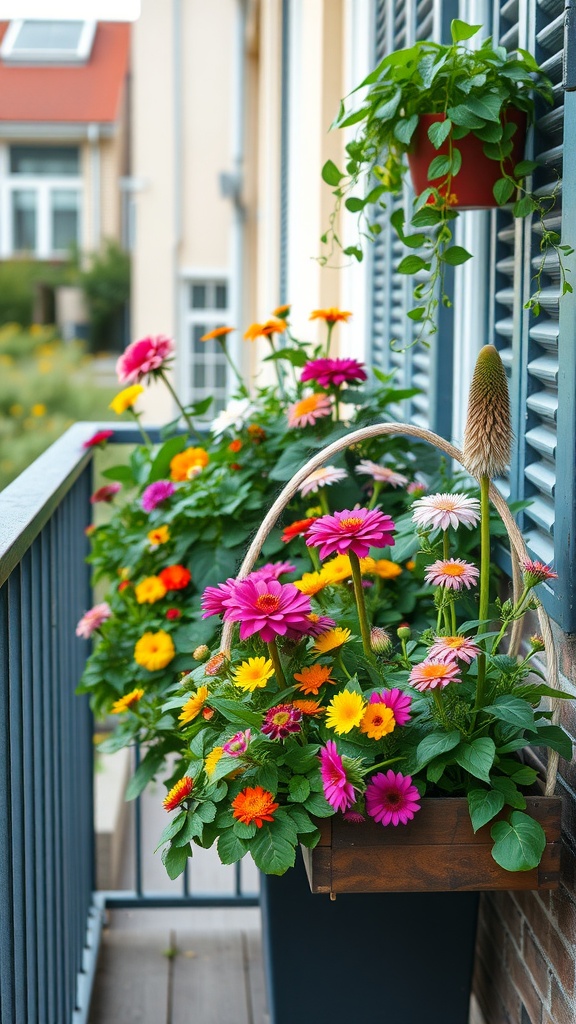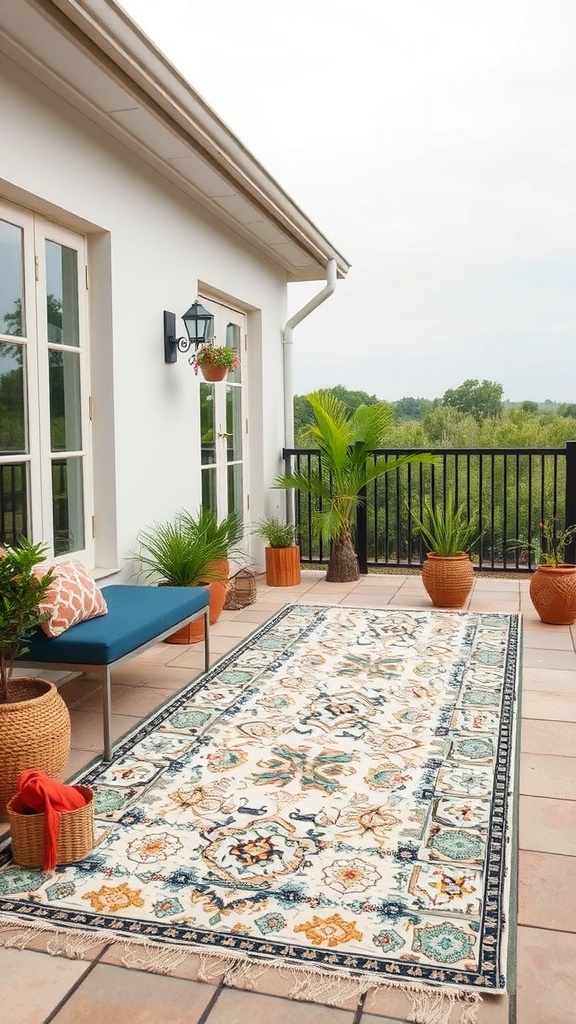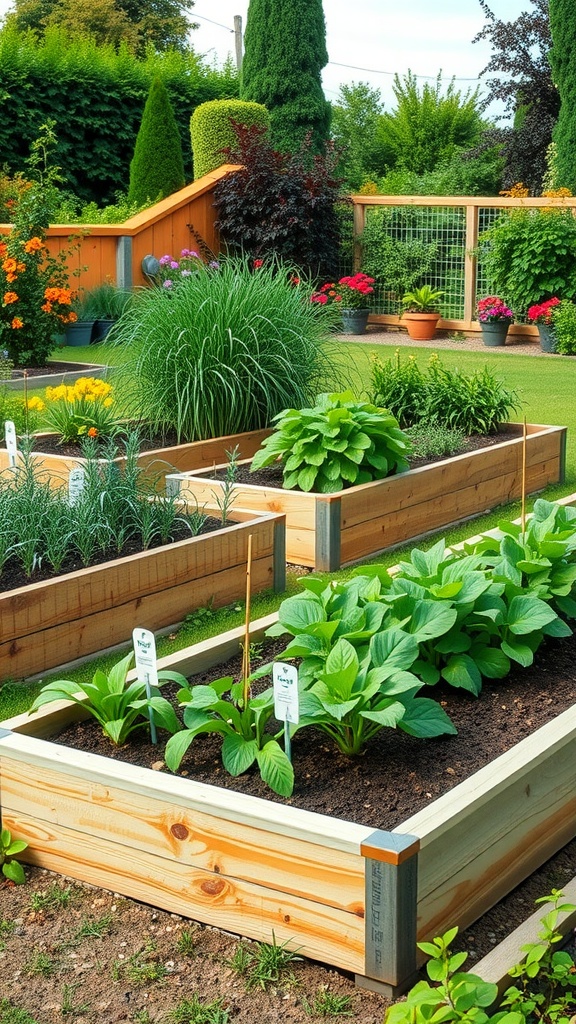If you’re dreaming of a vibrant veggie garden that brings fresh flavors right to your plate, you’re in the right spot. Here are 17 fun and creative ideas to help you grow your greens in style. From vertical gardens to raised beds, let’s get those plants thriving with a bit of flair and personality!
Square Foot Gardening Layout

Square foot gardening is a fun and efficient way to grow a variety of vegetables in a limited space. The image shows a well-organized garden bed divided into sections, each containing different plants. This layout makes it easy to keep track of what you’re growing.
The labeled sections are a great feature. Knowing what each plant is helps you take proper care of them. From leafy greens to herbs, this layout allows for diverse planting while maximizing the use of space.
This method is perfect for anyone looking to start a veggie garden. It simplifies planting, care, and harvesting. Plus, it can be a delightful project for families to work on together!
Vertical Gardening Techniques for Small Spaces
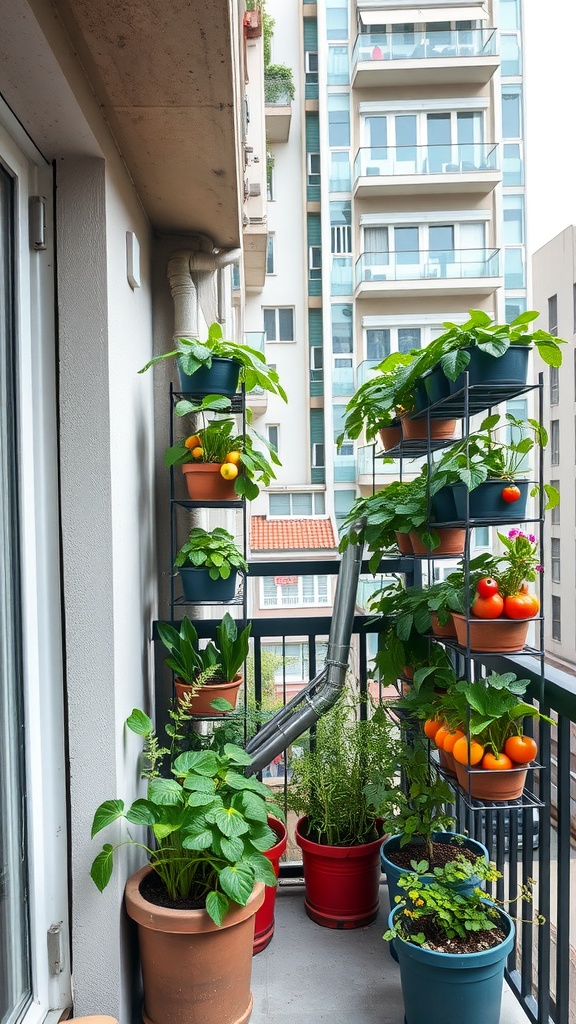
Vertical gardening is a fantastic way to make the most of limited space, like a balcony or small patio. The image shows a well-organized vertical garden that maximizes space while adding a burst of greenery and color. Stacked planters hold a variety of vegetables and herbs, creating a lively and productive garden.
Using vertical space not only saves room but also makes plants easier to tend to. Herbs like basil and mint thrive in this setup, while tomatoes and peppers can also grow happily in pots. This method provides good air circulation and sunlight exposure, which are essential for healthy plants.
Consider using tiered shelves or hanging planters to create a similar setup. You can easily customize the arrangement based on your preferences and available space. Keep in mind that using lightweight pots helps prevent damage to your balcony or walls.
Raised Bed Garden Benefits
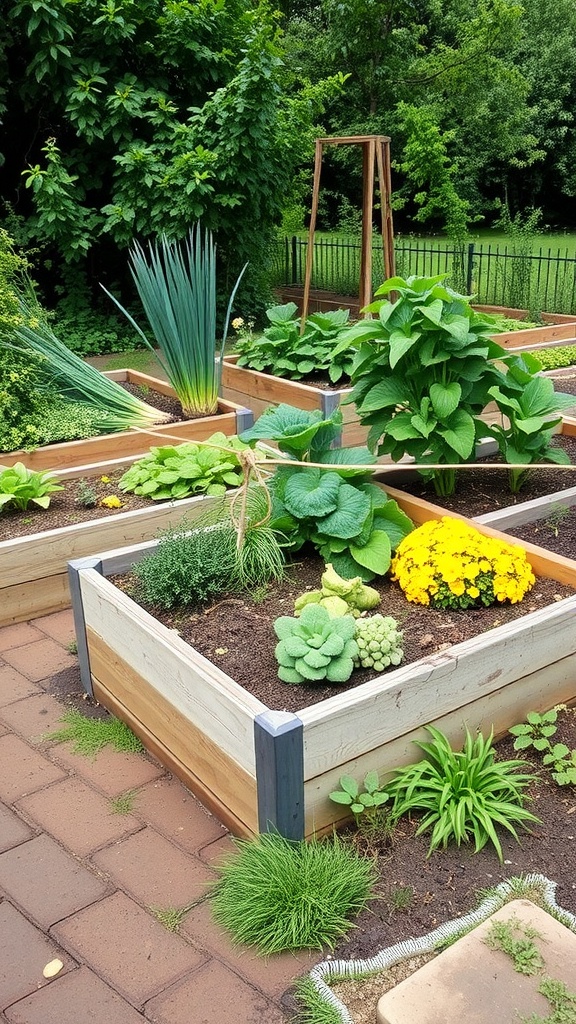
Raised bed gardens are a fantastic choice for any veggie enthusiast. The image shows a vibrant layout of raised beds filled with various plants, showcasing how inviting and organized these gardens can look. Each bed provides ample space for growing a variety of vegetables and herbs.
One of the biggest perks of raised beds is improved soil drainage. The elevated structure allows excess water to escape easily, preventing root rot. This is especially beneficial in areas with heavy rainfall.
Another great benefit is the convenience of gardening. Raised beds are easier to reach, making it less strenuous on your back and knees. You can spend more time enjoying your plants and less time bending over.
Consider the aesthetic appeal as well. The neat, defined borders of raised beds can enhance your garden’s appearance. They create a tidy and purposeful look, making your gardening space feel more like an oasis.
Moreover, raised beds can help with pest control. When elevated, plants are less accessible to some ground-dwelling pests, giving them a better chance to thrive. This is a simple yet effective way to boost your garden’s health.
Companion Planting for Healthier Crops
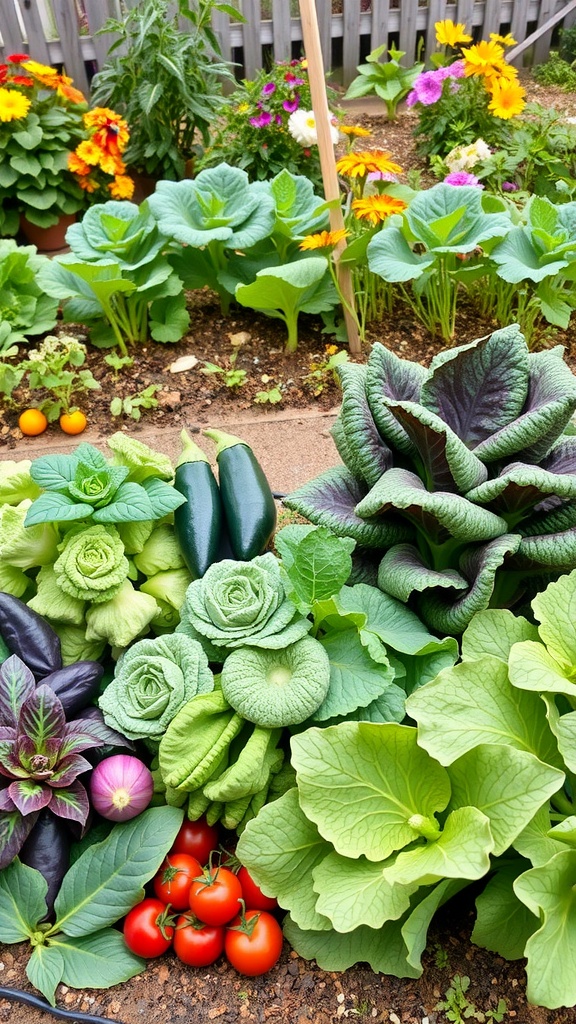
The image shows a vibrant veggie garden bursting with life. You can see a variety of vegetables like cabbages, zucchinis, and tomatoes, alongside colorful flowers in the background. This delightful mix not only makes the garden beautiful but also plays a big role in companion planting.
Companion planting refers to the practice of growing different plants together to enhance growth and pest control. For instance, tomatoes thrive when planted near basil, while cabbage does well with onions. This synergy helps to keep pests at bay and supports healthy growth.
In our garden, the mix of plants creates a balanced ecosystem. The flowers attract beneficial insects like pollinators and predatory bugs that can help control pests naturally. This method allows you to grow your crops without relying heavily on chemical interventions.
To achieve a thriving garden, think about what plants work well together. Planning your layout can make all the difference. The image captures the essence of this, showcasing how a diverse planting arrangement leads to a healthier and more productive garden.
Herb Spiral Design for Flavorful Cooking
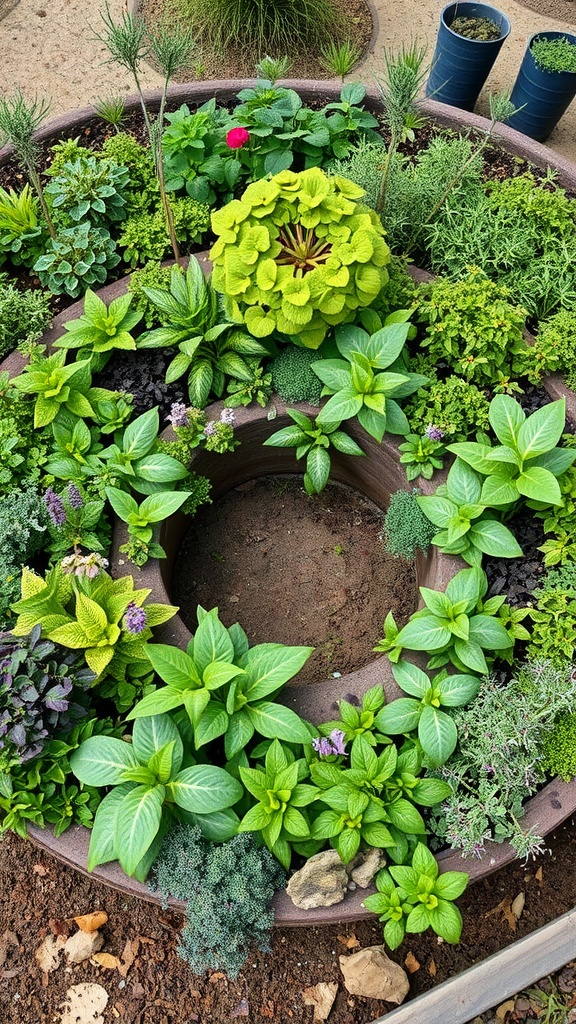
Creating a herb spiral is a fantastic way to grow fresh herbs right in your backyard. This unique design not only saves space but also allows for a variety of herbs to thrive in one area. The spiral structure takes advantage of different moisture levels and sunlight exposure, accommodating the needs of diverse plants.
In the image, you can see a vibrant herb spiral filled with lush greenery. The plants are arranged in a circular pattern, with taller herbs at the top and shorter ones cascading down. This layout not only looks appealing but also makes it easy to access each herb when cooking.
When planting in an herb spiral, consider using herbs like basil, mint, rosemary, and thyme. These herbs add flavor to numerous dishes and are simple to grow. Regular harvesting encourages healthy growth and ensures you always have fresh herbs on hand for your culinary creations.
Besides functionality, the herb spiral adds beauty to your garden. The diverse colors and textures of the plants create an eye-catching focal point. Whether you’re an experienced gardener or just starting out, building an herb spiral is a fun and rewarding project.
Permaculture Principles in Vegetable Gardening
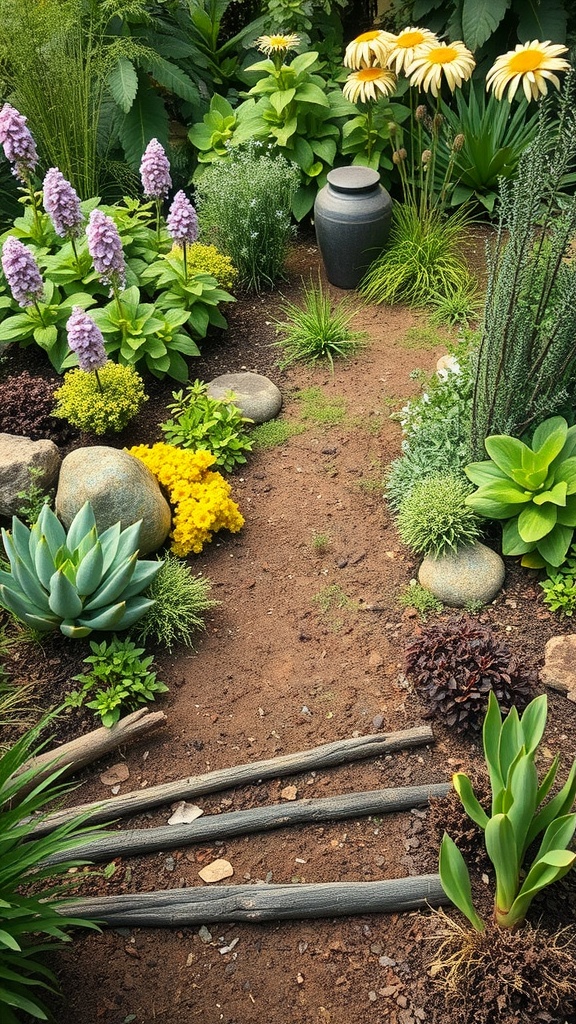
Permaculture is all about creating a sustainable garden that works with nature rather than against it. The image here captures a beautiful and flourishing garden space. It shows a mix of vibrant flowers, lush greenery, and carefully placed rocks that create a natural feel. The arrangement looks inviting and organized, showing how different plants can coexist harmoniously.
This garden utilizes permaculture principles by focusing on diversity. The variety of plants helps attract beneficial insects, which is vital for pollination and pest control. By incorporating flowers with vegetables, you create a thriving ecosystem that can naturally maintain itself.
Another important aspect is the soil management shown in the image. Healthy soil is essential for any garden. The plants are surrounded by rich, dark soil, promoting healthy root growth. Adding organic matter, like compost, can boost soil fertility and structure.
The use of natural materials, such as the stones and sticks in the pathway, aligns with permaculture’s goal of reducing waste. They serve a purpose while blending seamlessly into the garden’s design, showcasing how beauty and functionality can coexist.
Finally, observing and mimicking nature is key in permaculture. This garden layout reflects natural patterns, allowing for better water management and plant relationships. Embracing these principles can lead to a productive and resilient vegetable garden.
Shade Tolerant Vegetables for Partial Sun
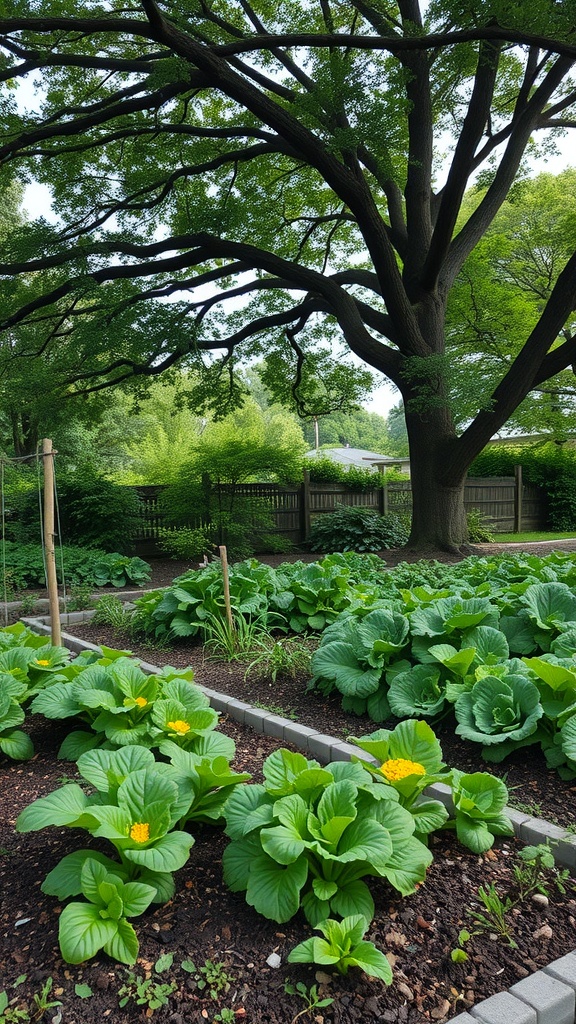
Gardening in partial sun can be a rewarding experience. It opens up a world of possibilities for growing shade-tolerant vegetables. The image shows a thriving garden under the canopy of a large tree. The lush greenery of the plants hints at their resilience in less direct sunlight.
In this setup, you can see broad, leafy greens and some vibrant yellow flowers peeking out. These could be vegetables like Swiss chard or even certain varieties of cabbage, which thrive in the dappled light.
When planning your garden, think about vegetables like lettuce, spinach, and kale. These plants do well in shady spots, allowing you to maximize your garden space. You might also want to consider planting herbs like parsley or cilantro, which can thrive in partial shade.
Creating a cozy, shaded garden can also offer a great space for relaxing. It’s a perfect spot for a small bench or a chair where you can enjoy the beauty of your hard work. Embracing shade in your veggie garden can lead to a bountiful harvest, even in less sunny conditions.
Container Gardening for Limited Areas
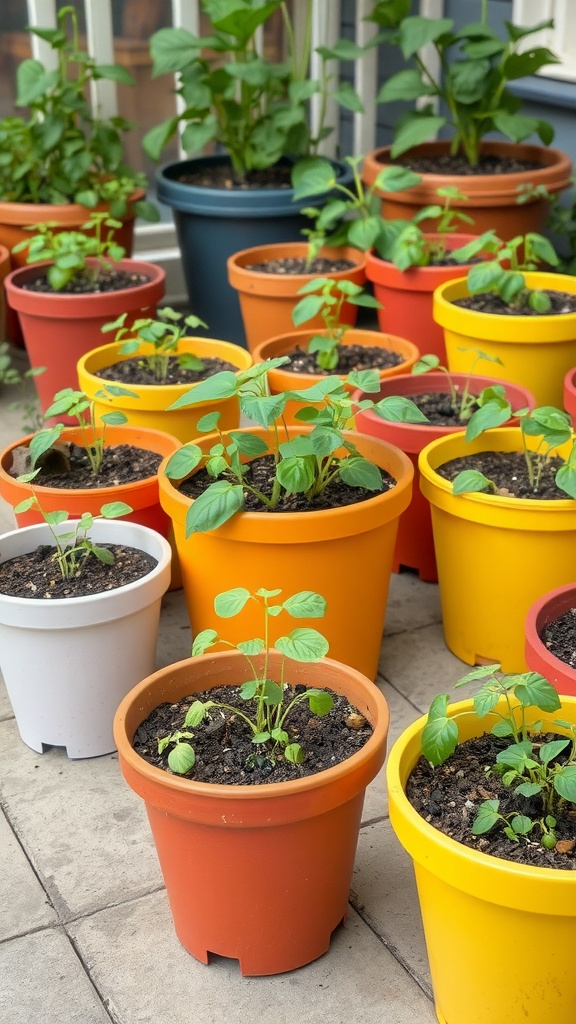
Container gardening is a perfect solution for those with limited space. If you live in an apartment or have a small backyard, you can still enjoy the benefits of growing your own veggies. The image shows a colorful array of pots filled with young plants, showcasing how you can create a vibrant garden even in a confined area.
Using different sized pots allows you to grow a variety of vegetables, from tomatoes to herbs. The colors of the containers not only add beauty but can also reflect your personality and style. You don’t need a traditional garden bed to cultivate fresh produce; with just a few pots, you can easily set up your own mini garden.
Make sure to choose the right soil and provide adequate drainage for your plants. Consider placing the containers in a sunny spot, as most vegetables thrive in sunlight. Regular watering is essential, especially in warmer months. With a little care and attention, your container garden can flourish and provide delicious veggies right at your doorstep.
DIY Drip Irrigation System for Efficiency

Setting up a DIY drip irrigation system can really boost your veggie garden’s productivity. The image shows a neat arrangement of plants, with a series of drip tubes running alongside them. This system allows for targeted watering, ensuring each plant gets just what it needs.
Drip irrigation is a smart choice for conserving water. Instead of soaking the entire garden, it delivers moisture directly to the roots where it’s needed most. In the picture, you can see the tubing and emitters placed strategically, making it easy to keep your plants happy.
If you’re looking to set one up, start by gathering materials like tubing, connectors, and emitters. Position the tubing along your rows of veggies, and attach emitters at intervals suited to each plant’s needs. Once everything’s in place, simply connect it to a water source and watch your garden thrive.
Winter Vegetable Gardening Techniques

Winter vegetable gardening can be surprisingly rewarding. The image shows a cozy garden bed, covered with a protective layer to shield the plants from the cold. Underneath, vibrant greens and charming pumpkins peek out, indicating life even in the chill of winter.
One effective technique is using row covers. These lightweight fabrics help retain warmth and moisture, allowing plants to thrive. It’s a simple way to extend the growing season, even when temperatures drop.
Choosing hardy varieties like kale or spinach works wonders during this season. These plants can withstand frost and often taste sweeter after a cold snap. Incorporating mulch can also protect the roots and keep the soil temperature stable.
Don’t forget about planning your garden layout! Grouping similar plants together can help with maintenance and yield. Plus, it makes for a lovely winter display.
Winter gardening can be a unique experience. With a little care and creativity, you can enjoy fresh veggies throughout the colder months!
Edible Landscaping for Aesthetic Gardens
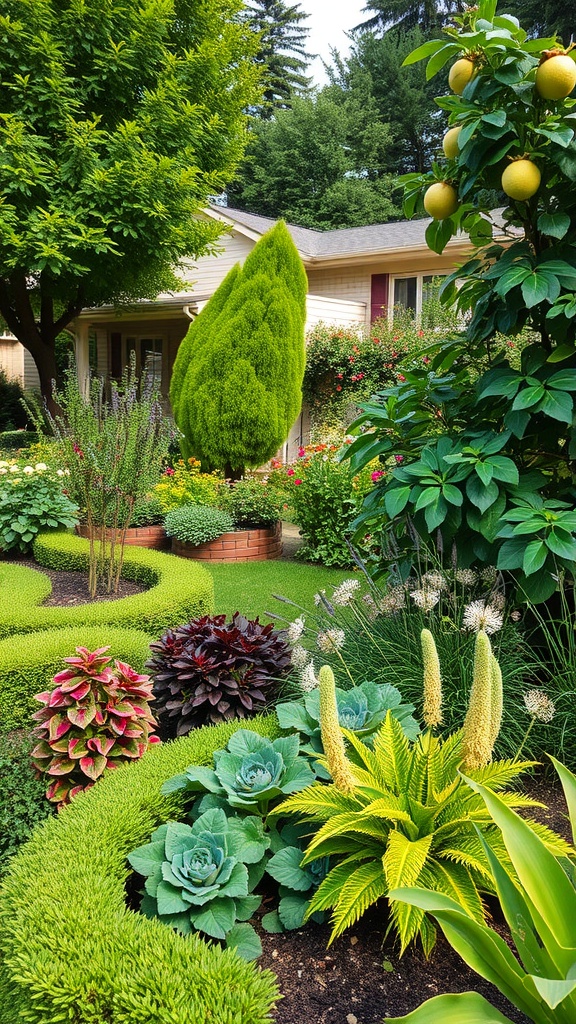
Creating a beautiful garden with edible plants can be a joyful experience. In this image, you see a vibrant garden filled with a mix of greenery and colorful plants, perfect for adding both beauty and function to your outdoor space.
The lush, manicured edges of the garden draw the eye. You can spot various plants, including decorative options like leafy greens and eye-catching flowers. These choices not only fill your garden with life but can also be used in your kitchen.
Incorporating fruit trees, like those seen in the background, is a smart way to blend aesthetics with edibility. Imagine picking fresh lemons right from your garden! Edible landscaping maximizes space while making your home inviting.
With a little imagination, you can turn any area into a productive and beautiful space. From herbs to vegetables, the options are endless. Start small and gradually expand your garden, crafting a landscape that’s as pleasing to the eye as it is to the palate.
Pollinator-Friendly Veggie Gardens
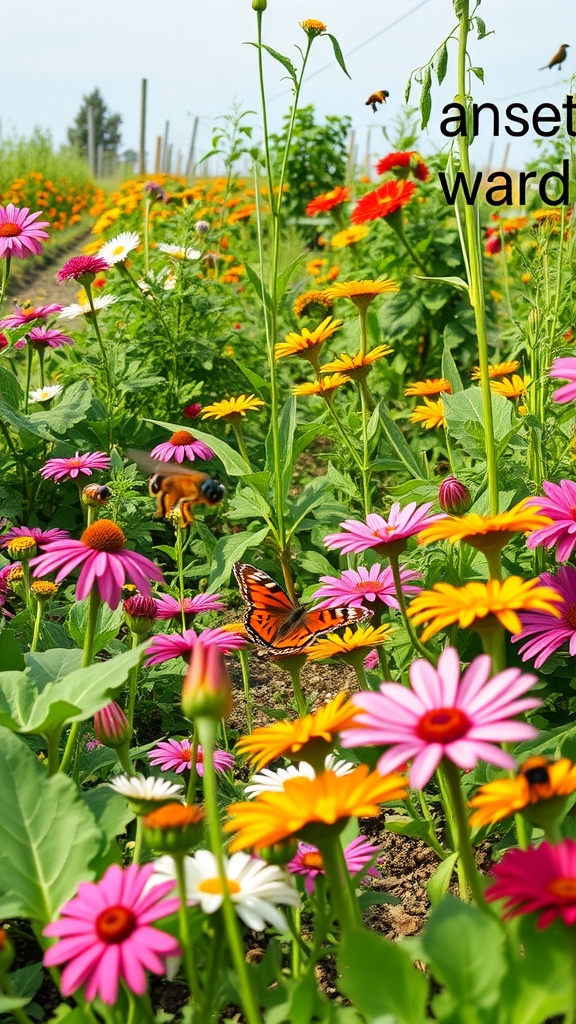
Creating a pollinator-friendly veggie garden is a delightful way to enhance your yard and support local wildlife. The image showcases a vibrant garden filled with colorful flowers, attracting bees and butterflies. These pollinators play a critical role in helping your vegetable plants thrive.
Incorporating flowers like zinnias and daisies among your veggies can create a beautiful mix. This not only brings life to your garden but also provides essential nutrients that make your vegetables even tastier. It’s a simple addition that can yield great results.
Having a variety of blooms ensures that there’s food available for pollinators throughout the growing season. Different flowers bloom at various times, creating a continuous source of nectar. This, in turn, will help your vegetables set more fruit and improve the overall yield.
So, when planning your garden layout, remember to include some flowers. It’s a fun way to create a lively space and give a helping hand to our buzzing friends.
Seasonal Vegetable Rotation Strategies
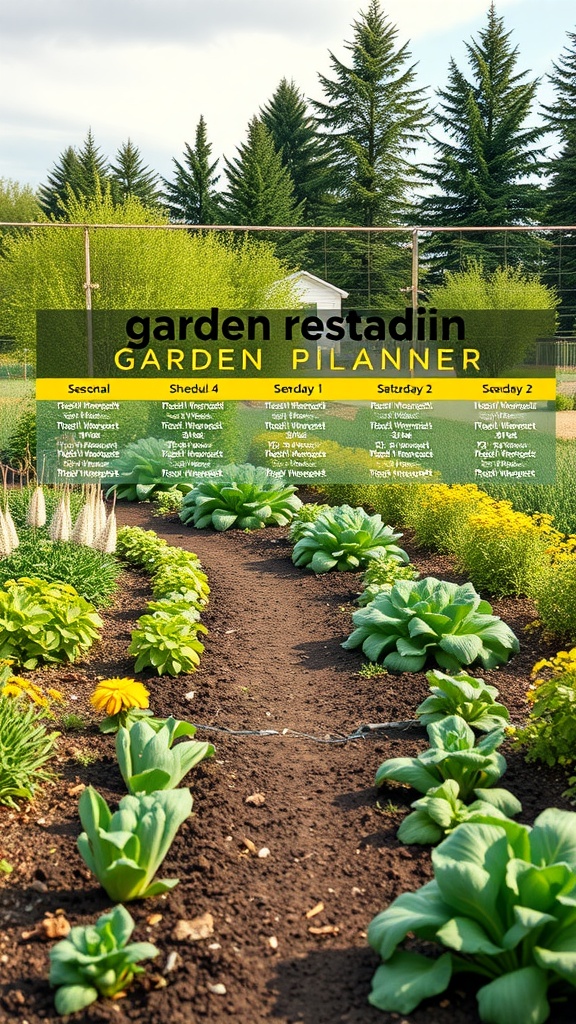
Keeping a veggie garden thriving takes some planning. One great way to do this is through seasonal vegetable rotation. The image above shows a garden planner that lays out different vegetable schedules across the seasons.
By rotating crops, you can improve soil health and reduce pest issues. For example, planting leafy greens in spring can give way to root vegetables in summer. This method prevents nutrient depletion and supports a balanced ecosystem in your garden.
The garden planner shown organizes tasks by days and tends to different types of veggies, helping you stay on track. It’s like a personal guide for your gardening journey. Plus, seeing your plants flourish in their designated seasons is incredibly rewarding!
